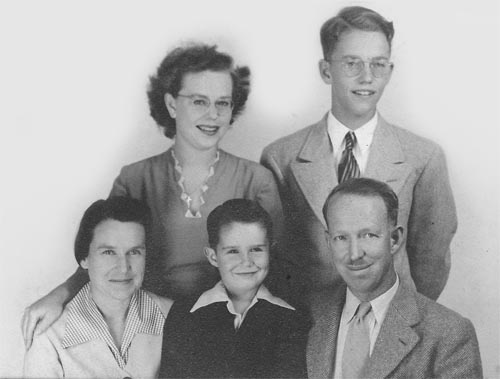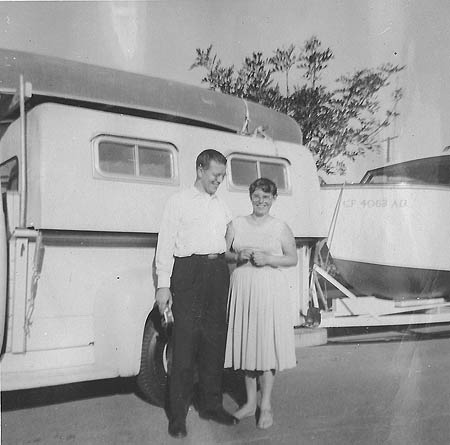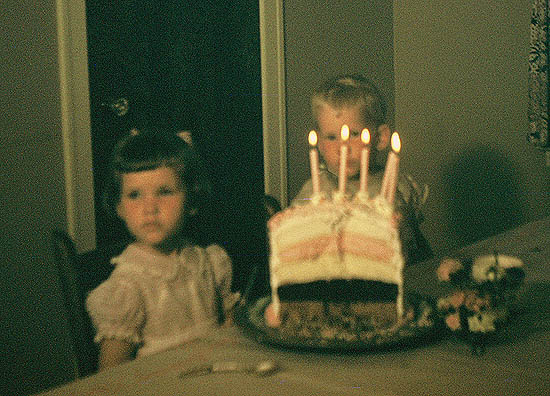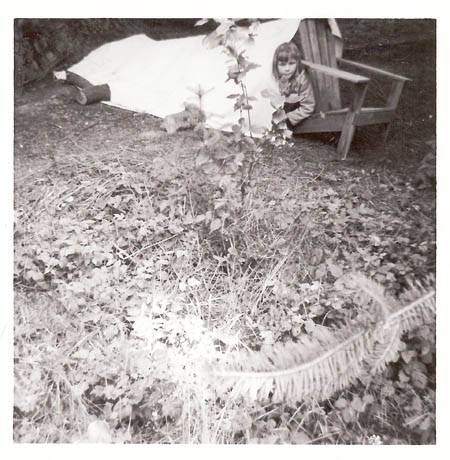Nancy's Story |
| · |
Buffalo, June, 1951 |
| · |
Williamsville, 1953 |
| · |
Williamsville, 1954 |
| · |
Williamsville, 1955 |
| · |
Williamsville, 1956 |
| · |
Williamsville, 1957 |
| · |
Cross Country, 1957 |
| · |
Santa Barbara, 1957 |
| · |
Santa Ana, 1958 |
| · |
Santa Barbara, 1958 |
| · |
Santa Barbara, 1959 |
| · |
Santa Barbara, 1960 |
| · |
Brookings, 1960 |
| · |
Santa Barbara, 1960 |
| · |
Santa Barbara, 1961 |
| · |
Santa Barbara, 1961 |
| · |
Santa Barbara, 1962 |
| · |
Santa Barbara, 1963 |
|
Brookings, Summer 1960
Pop's father, Roy Wesley Hendrick, was born November 14, 1899 to Thomas Jefferson
Hendrick (b March 10, 1861, Illinois) and Laura Malinda Fairman Hendrick (b October 19,
1865). Pop's mother, Viola Gockley, was born May 24, 1904 to Levi Gockley, Jr (b
March 24, 1874 in Illinois) and Maria Cora Thompson Gockley (b November 15, 1879 in
California.)
Grandpa Hendrick went to Stanford while Grandma Hendrick attended the University of
California in Berkley, then just known as "Cal." To visit each
other, Grandma told me, one of them had to travel by bus and street car between Palo
Alto and Berkeley, a trip that totaled two or three hours each direction.
Stanford, at that time, charged no tuition. It did, however, cost ten dollars
per quarter for room and board at a time when bread cost about a penny a loaf.
Grandpa felt that this was tantamount to highway robbery and retaliated when he
graduated by taking two red wool blankets with "LSJU" embroidered on them in
white when he left. (figure it out in today's currency using the price of a loaf
of bread and see why!) I think that makes those two blankets about the most
expensive ones in the world, but when he told me about it at my graduation from the same
institution, 50 years later, he was still happy about liberating those two
blankets.
Stanford was a very young school when Grandpa Roy attended it. Despite the fact
that it had been established only 30 or so years, but was already a bitter rival of
Cal. Grandpa and Grandma Hendrick were married secretly in their
senior year (a "mixed marriage", in Grandma Vi's own words) and spent part of
it with Grandma Vi traveling on weekends across the bay to spend the weekends in
Grandpa's dorm room -- all very much against university policy!
Gladys, grandma's friend and roommate from Cal was married to Roscoe Gockley,
Grandma's brother. Gla-ha, as we called her, was one of our very favorite
aunts and lived into her 90's. One of the last times I spoke with her, she told me
that she had taken a new job. She was "working with elderly
people." We had a good laugh because many of her clients were twenty
years, and in one case, thirty years, younger than she in biological age!
Grandma Vi and Grandpa Roy had two children -- Gladys (named after Gla-ha) and my
father, Roy Wesley Hendrick, Jr., born July 4, 1927. When Gladys was already
in college, everyone was very VERY surprised when Uncle Lee was born. As a result
of this little surprise, Lee is closer in age to me and my cousin Marie than he is to
his own siblings.

Grandma Vi, Gladys, Lee, Grandpa Roy and Pop
In the early part of the century, Grandpa Hendrick had bought a square of land close
to Brookings, Oregon. It had suffered a severe fire, but the original settler's
cabin and workshop (the original settler was a weaver) had been spared and were still
standing. Since Grandpa and Grandma were teachers, they were able to take
off large parts of the summer and work on the ranch to fix it up. Grandpa ran it
as a tree farm, growing mostly Douglas Fir.
Gladys became a teacher and married Paul Fox, another teacher. Their daughter,
Marie Fox, was born on February 29, 1948. For most of my childhood, they lived in
the tiny town of Shoshone in Death Valley and between the two of them, were able to
teach pretty much all the classes in the high school. Many of their students
were Indians and the one time I visited there with my parents, I though it was terribly
exotic. Later they moved to Egypt, where they taught for several years; they
concluded their teaching careers in Happy Camp, California, teaching at another Indian
school.
In the summer, Uncle Paul and Auntie Gladys, together with Marie would often go to
Oregon with their camper and canoe. They'd camp, back-pack, canoe down the Chetco
river and work on "the ranch".

Pop and Gladys with Gladys & Paul on their way to the Ranch.
Gladys and Paul had built a second, and more modern cabin on the
property. The original cabin was open, divided by a partial wall into a
kitchen and living area with a loft on the top that could be reached by a ladder.
The "Fox Den" was more conventionally constructed. It had a great room
where there was a fireplace, open space for a table and the master bed, then a small
bedroom with built-in bunks for Marie and a friend, a bathroom and a
kitchen. At the time, water had not been hooked up, so the bathroom was
unusable; cooking was generally done in the kitchen in the main cabin.
The summer that I turned nine, I was allowed to go to "the Ranch" for the
first time with Gladys and Paul. I slept in the lower bunk of the upper
cabin and Marie had the top one. There were windows next to the built in
bunks and when we woke up in the morning before the grown-ups, it was perfectly ok with
everyone if we just got dressed quietly, swung the windows outwards and went out to play
or visit Grandma or Grandpa at the lower cabin. It was, in fact, desirable,
because the doors to the Fox Den were very squeaky and there wasn't any way to sneak out
at all!
Technologically, the ranch hadn't changed very much since the property had been
settled in the late 1880's. The property had not qualified for free connection to
the power grid under the Rural Electrification Act of 1936 and Grandpa did not want to
pay to have the the lines run. So there was no electricity.
There were several excellent springs, so Grandpa and Uncle Paul had put in a
gravity-fed water system and there was running water at the lower cabin. To keep
things cool, there was a mesh box at the edge of the small stream that ran by the lower
cabin. Milk didn't last more than a couple of days, which meant we got to
drink Kool-ade, something strictly forbidden at home and which made me feel a little wicked and very grown
up. Sometimes there were long, interesting debates at breakfast about
whether or not the butter had turned.
Lighting in the evening was provided by kerosene or gasoline lanterns and as the
youngest, my job in the morning was to go round all the lanterns in the two cabins, trim
the wicks (kerosene) or check the mantles (gasoline), clean the glass and refill them so
they'd be ready for the evening. The gas lantern was particularly
important because everyone played bridge in the evenings and the bright light was
needed to make sure Grandpa was not cheating! Sometimes the games were held
under the apple tree in the yard of the lower cabin and sometimes they were held in the
Fox Den, but there was always a lot of laughing about it among the adults.
Marie and I did not play bridge, so when we got tired, we were allowed to use our
flashlights and go up the trail to the upper cabin. I liked the trail just
fine in the day, but when lit with a flashlight at night, the shadows were very scary. I
worried that the owls I could hear would swoop down and carry me off like the lamb had
been taken on Colgrove's property to the west of us.
Cooking was done on a wood stove (there was a TON of wood!) Uncle Paul or Grandpa
made sure that there was always kindling and stovewood. The stove was divided into
two parts: a firebox on the right and an oven on the left. To start the
stove, newspaper was crumpled up in the firebox and a few sticks of kindling placed
strategically on top of it. A match from the big box in the cupboard and scratched
on the rough surface of the stove to get it to light (no safety matches here!)
When the newspaper and kindling started burning well, pieces of stovewood were added,
the front of the firebox closed and the stove would start to warm. Note that
is "the stove" not "the burners." Unlike our gas stove
in Santa Barbara, where each burner could be turned on or off as desired, the entire
wood stove -- top, sides and front -- got hot. The hottest part was, of course,
next to the firebox, but the rest of it was very hot as well. It made that little
kitchen very warm in the summer and we all had to learn to be very careful not to touch
any part of it.
There was a water tank on the wall behind the stove, so by the time that breakfast
was fixed, there was enough hot water that people could take a shower in the outdoor
shower area off the porch and next to the kitchen. Since Marie and I weren't very
large, for bath time for us, there was an old copper wash boiler that Grandma Hendrick
would warm up with water from the teakettle:

Summer 1960 at the ranch -- just call me 'Bubbles'!
Grandma Hendrick was a great cook, but Auntie Gladys had a knack of being able to
whip up the most amazing meals from almost nothing. She made waffles a
special iron that fitted into holes in the the top of the wood stove and baked wonderful
crusty bread in the little oven. Over many summers at the ranch, she taught me how
to make bread too, but I don't think that mine has ever been as delicious as the first
slice of one of Gladys' loaves!
It is well known that the child is the one that "decides" it is time to be
born and I did a really terrible job of it. Mom organized wonderful birthday
parties, but to have a party, you have to have a birthday when your school friends were
around and I didn't. If I'd only managed to be about three weeks premature,
everything would have been fine, but I had the poor judgment to wait and be born at the
end of June. I remember being so disappointed in second grade when I
went around to deliver invitations to the girls in the neighborhood who were my age
(Jill, Jill, Betsy and Judy) only to find that no one could come because they were all
on vacation or at camp. Mom always did a great job on family birthdays -- I
remember her tolerantly serving a birthday meal of my favorite fried chicken, mashed
potatoes, cream gravy and chocolate milk -- a dreadful combination -- but it just
wasn't the same as getting dressed up and having a "real" party with favors,
poppers and little paper candy cups. Or doing any of the wonderful things Mom
could think up for a party: a camping trip to Red Rock or even a ride on the train!
No one dressed up at the ranch and the thought of Grandpa and Grandma donning paper
hats and tooting little celebratory horns was ludicrous. But Auntie Gladys did
something that was so great that it dwarfed the coolness of party paper goods: she baked
special birthday cakes with a layer of a different flavor for every year of the
celebrant's age! By the time anyone reached the age of eighteen, their cake
was an unsteady sort of ziggurat, but even one made for a five year old was impressive:

Five-year old birthday cake, 1956 (it is very hard to see, but the
holders are, to my certain knowledge, little wooden pig's heads. Go figure!)
That year at the ranch, Auntie Gladys made me a nine-layer cake
with every single layer baked in the oven of that wood stove! We ate it with
homemade ice cream and it was glorious!
With no clocks, the days seemed endless and I loved the ranch
unreservedly.
Almost.
I did not love the outhouse!
Grandpa had dug a deep hole and constructed a shack over it, about 3 feet
square. There was a seat built into it and (in what seemed a cruel parody to
me), a normal white toilet seat set on it. There was toilet paper at least,
but the equivalent of flushing was to take the shaker can of lime and dust a bunch of
powder down the hole before closing the lid.
Ewwwwwww!
I hated it!
Mom had told me a story about one of her older relatives (her great
grandmother, I believe) who had refused to have indoor plumbing installed when it became
popular in the 1800's. The lady's grounds were that it was a disgusting to have one
of "those things" in your house. Until I went to the ranch, I'd
thought that a benighted attitude, but my practical experience with the outhouse caused me
to swiftly change my opinion. It was disgusting and she was right: no one in
their right mind would want one in their home. Or anywhere else!
We did not spend all summer at the ranch. When Grandpa and Grandma
retired, they had built a place on Pioneer Lane in Brookings and moved there from the Los
Angeles area. Although they spent a lot of time at the ranch in the summer, they
actually lived in Brookings. The property on Pioneer Lane featured a nice
stand of trees, a large grassy area and a GIGANTIC and very productive blackberry thicket
that Grandpa hacked paths into with his machete and from which came the makings for Auntie
Gladys' delicious blackberry pies.
The house was built in the shape of a "U". The bottom of
the "U" was a great room with a dining area and kitchen, one arm had two
bedrooms and two baths and the other one was all workshop/garage because Grandpa said that
in his retirement, what he really wanted was a great place to work! The bedrooms
were all in use that summer, but there was an entryway that was not used much, so I put my
sleeping bag there, right next to the bookcase and I was well pleased with the
arrangement. What could be better than sleeping next to books? Easy deal: I had my
trusty flashlight and when I was supposed to be asleep, I could reach out, quietly snake a
book out and hide it and me in the sleeping bag, secretly reading.
One day, using a tarp and a lawn chair, I made myself a tent:

I liked sleeping in the tent even better than being close to the bookcase
and the grandparents, incredibly tolerant, let me sleep in it for all the rest of my
visit.
I was very sorry when I had to go home, back to reality and start school.
|